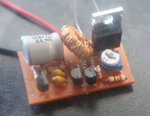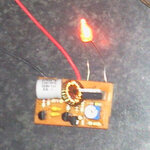dom444
Junior Member level 2

I wanted an easy to make High Voltage supply for neon and tube circuits so I came up with this compact adjustable and easy to make all transistor supply works down to 5V.
the coil is important and value shown works well, it works at 6KHZ with the capacitors shown.
there is an error on schematic capacitors are 33n not 100n




the coil is important and value shown works well, it works at 6KHZ with the capacitors shown.
there is an error on schematic capacitors are 33n not 100n




Attachments
Last edited:

